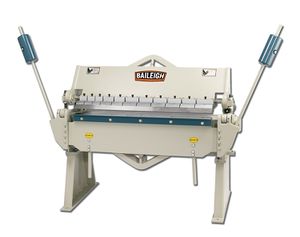Bending Brake
A bending brake is a metalworking machine that allows the bending of sheet metal. The brake in the shop is a Chicago W31 steel box and pan brake. In a box-and-pan brake (also known as a finger brake), the clamping bar includes several removable blocks, which may be removed and rearranged to permit bending of restricted areas of a piece of sheet metal or of already partially formed pieces. After bending, a box or pan form is then completed by screw, solder, weld, rivet, or other metal fixing process.
The current Ace of the Bending Brake is Nathan Hayward (nhayward21@georgefox.edu).
Resources
Training
Bending Steps
- Ensure that your sheet metal is thinner or equivalent to 14-gauge sheet metal, and ensure that it is less than 48" in width.
- If making a bend for a box or a pan, adjust the fingers so that the equivalent width of the fingers is just shorter than your sheet metal.
- Adjust the clamping force and the clamping handle to allow room to insert your work piece.
- Insert your work piece to the line you want to bend, centered in the brake, and clamp your piece securely.
- Pull up on the bending handle of the leaf slowly until your piece is bent to the desired angle, and slowly lower the leaf.
- If the piece does not bend straight, unclamp the handle on the overbent side and adjust the top leaf.
- Adjust the clamp handle, and remove your piece.
- Put back any fingers if adjusted, and deburr if any rough edges are left.
3 commandments
Stuff about the 3 commandments.
Safety First
- Always make sure your hands are out of the way of the fingers and all moving parts.
- Be aware of your surroundings to ensure that you do not bump others with the counterweight.
- If bending a small piece of metal, place it in the center of the brake.
- You may not use the sheet metal machines without safety glasses!! (Should be obvious if you are following the rules of the shop)
Reset the Space
Parts of the Machine
Make: Chicago Steel
Model: W31
Ace: Nathan Hayward (nhayward21@georgefox.edu).
Location: Machine Shop
Description
A bending brake is a metalworking machine that allows the bending of sheet metal. The brake in the shop is a Chicago W31 steel box and pan brake. In a box-and-pan brake (also known as a finger brake), the clamping bar includes several removable blocks, which may be removed and rearranged to permit bending of restricted areas of a piece of sheet metal or of already partially formed pieces. After bending, a box or pan form is then completed by screw, solder, weld, rivet, or other metal fixing process.
Here is an example of this piece of equipment being used.
Documentation
Terminology
User Manual
Training
Overview
Insert Text
Demonstration
Insert text
General Procedure
Bending Steps
- Ensure that your sheet metal is thinner or equivalent to 14-gauge sheet metal, and ensure that it is less than 48" in width.
- If making a bend for a box or a pan, adjust the fingers so that the equivalent width of the fingers is just shorter than your sheet metal.
- Adjust the clamping force and the clamping handle to allow room to insert your work piece.
- Insert your work piece to the line you want to bend, centered in the brake, and clamp your piece securely.
- Pull up on the bending handle of the leaf slowly until your piece is bent to the desired angle, and slowly lower the leaf.
- If the piece does not bend straight, unclamp the handle on the overbent side and adjust the top leaf.
- Adjust the clamp handle, and remove your piece.
- Put back any fingers if adjusted, and deburr if any rough edges are left.
Safety
Safety First
- Always make sure your hands are out of the way of the fingers and all moving parts.
- Be aware of your surroundings to ensure that you do not bump others with the counterweight.
- If bending a small piece of metal, place it in the center of the brake.
- You may not use the sheet metal machines without safety glasses!! (Should be obvious if you are following the rules of the shop)
Reset the Space
Certification
Foxtale Quiz
Troubleshooting
Maintenance
General maintenance
Insert text
Specific Maintenance Tasks
| Maintenance Procedure | Frequency | Done By |
|---|---|---|
| Sample | Sample | Sample |
